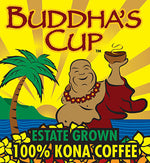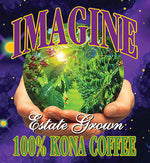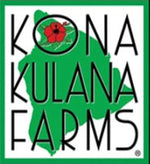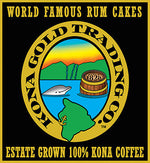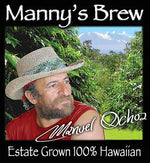Touch down on Hawai‘i’s Big Island and every sense comes alive. The salt of the ocean air, the green slopes rising above you, and the promise of a Kona coffee farm tour linger long after you leave. You may arrive for the views, but you stay for the story.
Because discovery tastes better on site, Kona coffee tours blend stories with sight, scent, and coffee tasting; together, they turn curiosity into appreciation.
Buddha’s Cup, established in 2004 in Holualoa, invites you to explore award-winning, single-origin Kona coffee grown across five biodynamic estates. In this guide, we’ll share how to prepare for a Kona coffee farm tour, what to expect, and tips to make your visit unforgettable.
Key Takeaways
- Plan your Kona coffee farm tour during bloom or peak harvest for the most scenic and flavorful experience.
- Smart Kona coffee farm preparation includes booking early, packing layers, and bringing sun protection.
- Kona coffee tours at Buddha’s Cup showcase tree-to-cup processes, from cherry picking to roasting.
- Visiting a Kona coffee plantation connects you to the region’s volcanic soil, climate, and hand-picking tradition.
- Kona coffee tasting teaches you how aroma, body, acidity, and roast levels shape the cup.
- Exploring single-origin Kona coffee estates offers traceability, flavor clarity, and a direct sense of place.
Why a Kona Coffee Farm Tour Is Special

Kona coffee is unique to its small growing region, where mineral-rich volcanic soils, gentle mid-altitude slopes, and a tradition of hand cultivation shape every harvest.
The result is a cup with remarkable clarity and a strong sense of place.
According to the University of Hawai‘i CTAHR, the Kona coffee belt stretches from 700 to 2,000 feet in elevation. Mild temperatures in this range balance flowering and ripening, creating beans with consistent flavor and depth.
Buddha’s Cup welcomes visitors to explore five biodynamic, single-origin Kona coffee estates. Here, farming methods, roasting choices, and guided tastings connect flavor to both place and practice.
On a typical Kona coffee tour, you’ll follow the journey from tree to cup and discover why each step matters:
- Tree and cherry: Only the ripe red fruit is picked, ensuring sweetness and clarity in the cup.
- Pulping and washing: The skin and mucilage are removed, creating a clean bean ready for controlled fermentation.
- Drying: Beans are carefully dried to the right moisture level, protecting aromatics and extending shelf life.
- Milling and grading: Beans are sorted by size and density to ensure even roasting.
- Roasting and tasting: Profiles are compared side by side, connecting process decisions to body, acidity, and finish.
For travelers and coffee lovers alike, this turns scenery into story and helps you appreciate what makes a Kona coffee plantation visit so memorable.
Best Time to Visit for a Fruity, Colourful Experience
Time your trip for Kona’s most vibrant months to catch blossoms, red cherries, and busy mills, while choosing weather windows for clear views.
Seasons and Coffee Cycle
Kona’s coffee year moves in clear phases.
Flowers appear after dry spells give way to rain, fruit swells through summer, and the harvest stretches across late summer into winter.
A study published in the Journal of Economic Entomology found that fruit ripening in Kona occurs mostly between July and December, with the peak harvest taking place in October and November.
The calendar at a glance:
- Bloom, “Kona snow”: late winter to spring, often February to April. Short, fragrant flushes blanket the orchards in white.
- Fruit set and development: spring into midsummer, roughly April to July. Green cherries grow and fill with sugars.
- Color change and ripening: midsummer onward, about July to September. Cherries shift from yellow to bright red.
- Harvest: The season runs from late summer through winter, typically August to January. Peak picking and milling take place in October and November, when the trees are full of ripe red cherries.
To participate in most activities, visit during the peak harvest season when picking, pulping, and drying are being conducted.
If you are looking for striking visuals, arrive during bloom for the “Kona snow” display and during ripening for rows of vivid red cherries.
Weather and Time of Day
Mornings on Kona’s slopes are usually bright and clear, with sweeping views over the coast. As the day warms, clouds drift in, and afternoon showers are common. For the best light and scenery, plan your visit early in the day.
Best months
- February–March: Short, fragrant bloom known as “Kona snow,” ideal for soft light and photos.
- August–January (peak around November): Ripe red cherry and active picking, pulping, and drying. It’s the most animated scene on the farms.
Less ideal
- Late spring lull (May–June): Fewer dramatic visuals between bloom and full harvest.
- Mid-summer afternoons: Humid air and upslope clouds often dim the views and bring quick showers, a pattern described by theWestern Regional Climate Center.
At Buddha’s Cup in Holualoa, tours are offered by appointment on weekdays between 10 a.m. and 3 p.m. Arriving earlier often means cooler air and wide, clear views across the coast.
Later in the day, you may catch pulping or drying in action, though afternoon clouds are more common as the slopes warm.
What To Book and Check Before You Go

Book early, double-check logistics, and choose experiences that match your pace. Next, we’ll cover essential tips on tickets, timing, transportation, and access.
Tour Tickets & Scheduling
Our tours are scheduled in advance, so it’s best to reserve your spot before you arrive. We welcome guests Monday through Friday between 10 a.m. and 3 p.m., with the farm closed on major holidays.
If you have a special request, let us know. We are happy to tailor the experience to your interests and make your visit memorable.
Reservations and timing
- Appointment required: Book in advance since tour hours are limited and slots can fill quickly!
- Group vs private: Standard guided options host small parties, while Deluxe and VIP owner-guided tours offer a more private pace with limited availability.
- Seasonal flow: Activities you see can shift with the coffee cycle and weather, so milling or roasting may be included when operations are active.
- What We Offer
- Guided farm tour: A driving tour across the 80-acre property with on-farm activities and a tasting of coffees, teas, and Hawaiʻi-made products.
- Express ATV tour: A 30-minute Polaris ride across multiple estates, including a complimentary tasting.
- VIP owner-guided tour: Deeper access with limited spots; current rate listed at $165 per person, with kids 7–12 at half price and ages 6 and under free.
- Possible add-ons: Stops include the Blu Room, the wet or dry mill, and a roasting experience.
Payment and changes
-
Booking hold: A credit card confirms your reservation. Changes or cancellations are allowed up to 24 hours before arrival; inside 24 hours, the full fee applies.
For the smoothest visit, match your reservation to the part of the coffee cycle you want to see, then pick the tour format that fits your pace.
Location, Transport & Access
You’ll find the farms in the coffee belt above Kailua-Kona, tucked along hillside roads that climb steadily inland. The drive is short and scenic, and it helps to give yourself a little buffer so you can take the curves at an easy pace.
If you’re flying into Ellison Onizuka Kona International Airport, Holualoa sits roughly 11 to 12 miles away by road, so the trip usually takes under 30 minutes in normal traffic.
Most approaches use paved, winding roads that narrow in places.
As you arrive, follow posted signs to the visitor area, then park only in marked spots. Cellular service can dip on the slopes, so it’s smart to download your map in advance and download confirmation emails.
Footing varies with recent rain. You may walk short slopes or uneven ground between trees and drying areas, so wear closed-toe shoes.
With that, you can move comfortably, see the working parts of the farm, and still keep your visit relaxed.
What to Pack & Wear
Kona mornings start cool, afternoons can turn warm and humid, and brief showers often sweep the coffee belt during the growing season.
With smart Kona coffee farm preparation, you stay comfortable while moving between orchards, mills, and tasting rooms. According to the CDC’s Yellow Book, UV exposure is strongest near midday and increases at lower latitudes, so plan for sun protection.
- Footwear and clothing: Closed-toe, grippy walking shoes; light, breathable layers; a compact waterproof jacket for quick showers.
- Sun protection: Broad-brim hat, reef-safe sunscreen, and UV-blocking sunglasses for high UV hours.
- Hydration and comfort: Refillable water bottle, small snack or energy bar for longer tours, and insect repellent in case mosquitoes are active.
- Gear for the experience: Camera or phone for bloom and harvest scenes, plus optional binoculars for hillside views and wildlife.
What You'll See During a Farm Tour
Your tour begins in the orchards, where rows of coffee trees stretch across the slopes. Here you’ll see cherries in different stages of growth, learn about varieties, and notice the difference between shade-grown and sun-grown coffee.
Next comes harvesting. Kona coffee is always handpicked, and you’ll discover how careful selection of only ripe red cherries preserves sweetness and quality. It’s slow work, but it’s part of what makes the cup so distinctive.
From there, you’ll move into processing.
Cherries are pulped to remove the skin, fermented to develop character, and sun-dried on open-air decks before being sorted. Each stage adds its own influence to flavor and aroma.
Roasting is where the magic comes alive. You’ll learn how roast levels affect body, acidity, and taste, then experience cupping, a tasting method that compares coffees side by side.
Finally, you’ll see how beans are stored and profiled before roasting. This step ensures consistency and connects the entire process back to terroir, giving you a full picture of how Kona coffee moves from tree to cup.
How to Taste Coffee Like a Pro on the Farm

Start by slowing down. You are here to let aroma, flavor, and feel tell the story of place and process.
- Smell first. During Kona coffee tasting tours, notice the aroma first, since coffee contains over 800 identifiable aromatic compounds. Notice florals, citrus, stone fruit, nuts, cocoa, or spice. Return to the cup as it cools, since new notes often appear.
- Slurp and sip. Take a small spoonful and slurp to spread the coffee across your palate while introducing air. Gauge acidity for liveliness, body for weight, sweetness for balance, and finish for length and clarity.
- Compare thoughtfully. Taste light, medium, and dark roasts side by side to see how roast level shifts aroma and body. Then compare varietals common in Kona, and note how single-estate lots can show different elevation, shade, and drying choices.
- Ask focused questions. Invite your guide to explain how washed, honey, or natural processing shaped the cup. Explore differences between estates, harvest passes, and roasting profiles.
- Take simple notes. Jot a few descriptors, mark your favorites, and record roast level and brew method. Rinse spoons between cups, sip water to reset, and enjoy the discovery.
Make the Most of Your Tour Experience
Arrive a little early to beat the heat and crowds, and the light stays soft for photos.
Settle in, greet your guide, and let the day unfold at a calm pace. Ask about pruning, soil, water use, and drying choices, then follow up with roasting and tasting questions so you can link fieldwork to flavor.
Bring a short list of coffees you enjoy, compare those profiles during flights, and jot quick notes.
When visiting our Kona coffee plantation, budget time for the full flow: walking, tasting, and a relaxed shop stop.
Finally, respect the farm, stay on paths, and follow instructions carefully.
After the Tour: What to Do Next
The first step after your Kona coffee farm tour is to take home some beans. If available, grab single-estate lots. These carry the pure expression of place and give you a taste of the orchards you just walked through.
Once home, keep your beans happy. Store them in an airtight, opaque container at room temperature, away from heat, moisture, and direct light.
If you’d like to stock up, pre-portion beans into small sealed bags and freeze them. Just remember to let each bag thaw while sealed before brewing.
At home, try brewing the way you learned on the farm. Start with a 1:16 coffee-to-water ratio, then adjust the grind size until the balance of acidity and body matches your taste. French press, pour-over, or drip methods all work beautifully.
Finally, share the experience. Post photos, talk about the flavors you noticed, and use your new knowledge when buying coffee again. Each cup becomes a reminder of the Kona slopes and the craft that brought it to life.
Ready to Plan Your Kona Coffee Farm Tour?

Good planning transforms a scenic visit into a memorable experience. By choosing the right season, reserving ahead, and packing thoughtfully, you’ll see the farm at its most vibrant and enjoy Kona coffee at its freshest.
Buddha’s Cup in Holualoa makes the choice easy.
Since 2004, our team has shared award-winning, single-origin Kona coffee grown across five biodynamic estates. On the tour, you’ll stroll through the orchards, see the processing in action, and end with a guided tasting that connects each step of the journey to the flavors in your cup.
If you’re set to go, map your timing, gather your questions, and reserve a spot. To check availability or customize your visit, plan your visit with Buddha’s Cup.
FAQs
1. When is the best time for Kona coffee tours, and what will I see?
Visit during peak ripening from late summer to early winter for rows of red cherry and lively processing, or come in spring for fragrant “Kona snow.” Either way, you’ll walk orchards, watch milling or drying, and taste fresh brews that connect process to flavor.
2. What should I wear and bring for Kona coffee farm preparation?
Choose closed-toe shoes with a good grip and wear breathable layers.
Pack reef-safe sunscreen, a hat, and water. Showers can pass quickly, so add a compact rain jacket. For Kona coffee farm preparation, carry a small daypack for snacks and insect repellent.
3. What do single-origin Kona coffee estates mean, and why does it matter?
Single-origin Kona coffee estates produce beans from one defined farm or sister estates in the Kona belt, not from mixed regions. You gain traceability, consistent practices, and a clear flavor signature. As you taste, you can link altitude, shade, and processing to the cup.
4. How long do Holualoa Kona coffee farm tours take, and who are they for?
Holualoa Kona coffee farm tours typically range from quick 30-minute estate drives to deeper guided walks that last one to two hours, depending on the format. Families, photographers, and serious tasters all benefit, since guides adapt pace, accessibility, and tasting depth to your group.
5. What brewing tips should I bring home after Kona coffee tours?
During Kona coffee tours, ask for the brew recipe used on site, then recreate it at home. Start near a 1:16 coffee-to-water ratio, use fresh medium grind for pour-over, and adjust finer or coarser as you chase brightness, sweetness, or body.




